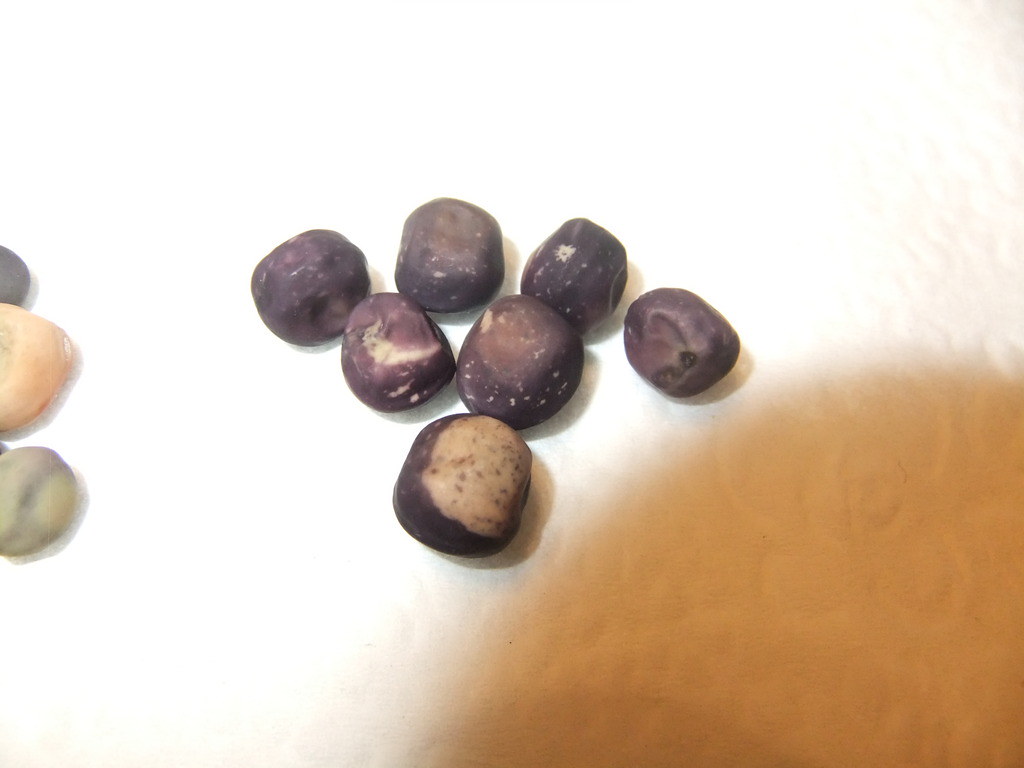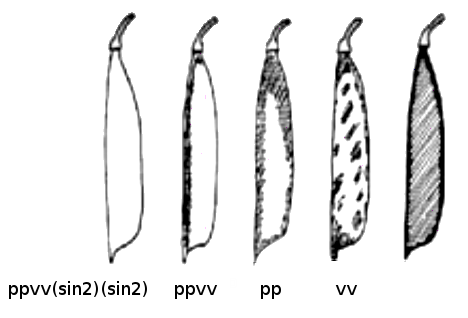|
|
Post by keen101 (Biolumo / Andrew B.) on Nov 27, 2015 13:50:35 GMT -5
oh, ok. i figured there was probably some humor in there somewhere, but i was having trouble finding it. no prob.
|
|
|
|
Post by farmermike on Apr 5, 2016 19:07:52 GMT -5
I would like to attempt some pea crosses, but first I need to figure out to actually save some seeds. For the past 2 years, something (I'm assuming rats) has eaten all of my snap pea pods just as they start to turn leathery. Yesterday I noticed that all the Cascadia pods I had been waiting on are suddenly gone. So, today I picked all the fully formed pods in that patch. My question is: Can I get viable seed from pods that have not started to dry down at all? These are a few of the Cascadia. Any potential? Most of these are as full and ripe as they get, but are still crisp and juicy.  Or maybe I should just choose a larger number of pods to save for seed (instead of eating them myself), so that the rats can't get them all before they begin to senesce. My 2 year old also eats a lot of the pods, but I don't think she takes them when they are past their prime eating stage. |
|
|
|
Post by Joseph Lofthouse on Apr 5, 2016 19:20:57 GMT -5
Three of the five pods look perfectly viable to me.
That's how I'm intending to pick my pea seed this year... Also to avoid predation, but in my case it's a we-evil that lays it's eggs in the seed, and eats the center out of them. So I'm intending to pick them early, and get them dried and into the freezer to kill the bugs.
I think that I managed to make and collect one hybrid pea seed last year. Alas, it had a hole eaten out of it. Joy. It germinated anyway! It was ([Earliest Shelling X Austrian Winter] X Red Podded). I attempted lots of crosses, most of them got lost in the patch, if they even took. It was a starchy pea... So I may attempt the cross again this year. I planted the pea patches more wide open, so that things are less likely to get lost.
|
|
|
|
Post by keen101 (Biolumo / Andrew B.) on Apr 5, 2016 19:46:35 GMT -5
I'll throw in my two cents, but i'm far from an expert in this department so i'd take others opinions over mine. 4/5 of those you might be able to shell and dry. The middle pod doesn't have a chance. Many of my Biskopens peas had to be harvested like that because they were still growing late into july and i decided to finally cut down all the pea vines. Plus Biskpens at 6+ ft high got damaged in a high wind. The point is that i was able to shell and dry most of the seed down in a glass mason jar. Another idea might be to look into harvesting the whole pea vine at the bottom and placing them in rose water to keep them alive to slightly extend the time for the pods to develop. Last year i had a rabbit nibble off my prize Virscens Mutante pea plant and in a long shot effort to save it i placed it in a flower vase with some liquid fertilizer. Surprisingly it survived for weeks and looked very nice with the white attractive pea flowers. I'm surprised pea flowers don't make it into flower vases more often. The cool thing was that the flowers pollinated and grew pods even without roots on the plant! The pods developed about half way mature when the pea vine finally started to rot away. If i had put it in with half formed pods to begin with i might have been able to harvest mature seeds from it. i1010.photobucket.com/albums/af224/keen101/Garden%202015/DSCF7071_zpsiegzu4mk.jpgi1010.photobucket.com/albums/af224/keen101/Garden%202015/DSCF7073_zps7lslqsht.jpgi1010.photobucket.com/albums/af224/keen101/Garden%202015/DSCF7080_zps9nelxn6j.jpgi1010.photobucket.com/albums/af224/keen101/Garden%202015/DSCF7082_zpsqvfeaups.jpgBut planting more seeds than you need might not be a bad idea. Or you could poison the rats if your into poison. Or not. Or both. Whatever works best for you. |
|
|
|
Post by diane on Apr 5, 2016 21:40:13 GMT -5
I sow the mature but still green peas and they germinate just fine. I can get two or three crops a year.
|
|
|
|
Post by steev on Apr 5, 2016 22:18:09 GMT -5
FarmerMike: sure it's not a squirrel (tree-rat)? So far as your two-year-old eating your peas, it's not a loss, just a longer-term investment; if she gets properly invested in the whole garden-thing, you'll reap benefits when you're too old to garden.
Keen101: those flower-vase peas are called "sweet peas".
|
|
|
|
Post by steve1 on Apr 6, 2016 4:54:48 GMT -5
My two cents worth... It depends how much you want to keep the pods. I have been forced to make pouches out of pet mesh (a sort of tough fly wire) to keep my crosses. Just cut a square fold in half and staple using an office stapler up the sides and across the top. The pet mesh pouch means that you have a much greater chance of finding important crosses later. If you are making pouches for rats you might have to find something that's heavier duty. If you are desperate you can graft peas to save special vines, but they often grow easily as a cutting too. Mouse proof pouch www.dropbox.com/s/icqhrd92sshsk44/smallpeapouch.jpg?dl=0 |
|
|
|
Post by farmermike on Apr 11, 2016 12:26:40 GMT -5
Thanks all! That is encouraging. I think I should at least get back as many seeds as I planted of the Cascadia and Sugar Lace II. The Sugar Lace II, though, did overlap in its flowering, with the Swedish Red soup peas (4' away). Should I expect some crosses? Joseph, good luck with the pea crosses this year! I had been wondering recently if wider spacing would also help a lot when selecting and culling peas in general. Seems like it would be easier to identify productivity or disease resistance, than when many plants are intermingling. Incidentally, the snap pea harvest coincided with potty training of our toddler. So, it caused a lot of confusion around our household, that "I want a pea!", and " I want to pee!", sound exactly the same out of the mouth of a 2 year old.  |
|
|
|
Post by Joseph Lofthouse on Apr 11, 2016 17:51:07 GMT -5
The thing that helped me most with separating different traits in peas was growing in a single row on a trellis... Each vine tends to grow straight-ish up so it makes sorting them easier at harvest time.
With dwarf peas, I can space them far enough apart to grow them as specimens.
|
|
|
|
Post by keen101 (Biolumo / Andrew B.) on Dec 24, 2016 11:41:54 GMT -5
I can't remember if i've shared this before or not, but here is the small collection of F1 seed from last years attempt to cross 'Mighty Midget' my favorite extra dwarf pea variety with 'Purple Passion' a weak pea with dark purple seeds. I think the cross was successful. Though i can't be completely sure i believe these were collected from Mighty Midget mother plants. As you can seed the seeds have the larger shape of Mighty Midget seeds, with some mottled gray speckling showing through on some, but have the dominant purple coloring. I'm looking forward to growing these out this year.  DSCF7994_zpsdjpfebav DSCF7994_zpsdjpfebav by Andrew Barney, on Flickr |
|
|
|
Post by keen101 (Biolumo / Andrew B.) on Mar 4, 2017 15:45:49 GMT -5
|
|
|
|
Post by keen101 (Biolumo / Andrew B.) on Apr 2, 2018 22:24:31 GMT -5
so today i was thinking about pea crosses i wanted to do. Then i thought "hey! i can use the pgene jic database and look up all the relevant genes i might be working with and be able to add whether they are recessive or dominant AND what chromosome they are on for possible linkage." So i did just that. I think i got everything right. Most are recessive genes. But i sorted them by chromosome so that way i can tell which crosses are going to be harder or impossible. If they are on separate chromosomes easy peasy. If they are on the same chromosome then not so easy, but potentially possible with crossover and breaking linkages. Just would require more crosses to be successful potentially. keen101.files.wordpress.com/2018/04/peas_genes.xlsxkeen101.files.wordpress.com/2018/04/peas_genes.pdf |
|
|
|
Post by keen101 (Biolumo / Andrew B.) on Apr 3, 2018 10:36:44 GMT -5
In addition i took a look at that video again on youtube with Dr. Jim Meyers (the one who bred the blue tomato) and found his pea pictures most enlightening on snap pea breeding and fiber genes.   Shelling Pea (top), Snow Pea (middle), Snap pea (bottom). |
|
|
|
Post by keen101 (Biolumo / Andrew B.) on Apr 3, 2018 11:00:57 GMT -5
i sorted them by chromosome so that way i can tell which crosses are going to be harder or impossible. So for example, It seems that hyper-tendrils (Semi-leafless) is on chromosome 1. It looks like one of the purple pod genes is also on chromosome 1. Therefore it makes sense that you do not see many purple podded peas with hypertendrils. Alan Kapuler's Sugar Magnolia is an exception to this, so obviously crossover can occur, but since he originally released it with all types i'm not sure how well the hyper tendrils have stuck around in my Sugar Magnolia population. I need to pay more attention to saving only the hyper tendrilled ones in that population. Also one of my crosses i wanted to do, purple seeds and yellow pods are on the same chromosome 5. So, i will probably need extra F1 and F2 seeds to get the combination i want for that having both. Also wrinkled seeds and yellow pods is on chromosome 5. But this year in my yellow podded row i only planted wrinkled seeds. So woo hoo! Also trying to breed a fasciated crown pea that has snap pods will be doubly challenging because v, and n, and fa are all recessive and on chromosome 4. That one will take some work. The best method would be to first get good snaps with n and v together and then cross to fa and hope for as little cross over as possible. Might need extra f2s as well. Also extra large pods (like carouby de maussane) and pod fiber gene p are both recessive and on gene 6 so hopefully they would stay together in crosses, but not guaranteed. |
|
|
|
Post by Joseph Lofthouse on Apr 3, 2018 16:17:12 GMT -5
It seems that hyper-tendrils (Semi-leafless) is on chromosome 1. It looks like one of the purple pod genes is also on chromosome 1. Therefore it makes sense that you do not see many purple podded peas with hypertendrils. Genes often sort independently, even on the same chromosome. Anyone have a guess at how many centimorgans long chromosome 1 is in peas? |
|